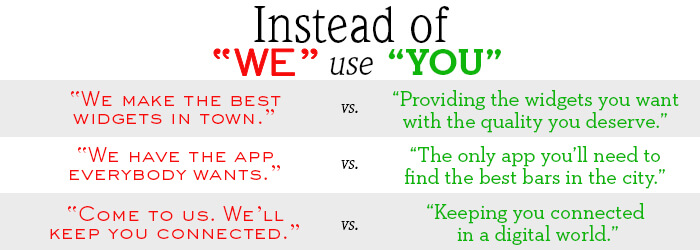
Whether your business is a fresh start-up or a veteran celebrating decades in the industry, it’s important that it exudes clear and consistent brand messaging. You want your customers to know exactly how your product or service can solve their problem, and you want to make a lasting connection between your company and the public.
The only way to do this is to understand your customer; know their wants and needs and illustrate how your business can fulfill them.
The mark of any successful company is its ability to facilitate improvement; to always look for opportunities to make the business better. There are many avenues for improvement, but maybe your company can benefit from a little brand maintenance. If so, read on. This post outlines ways to correct some common branding mistakes.
Be Proud, but Stay Customer-Focused
Filling the trophy case in the lobby with awards is surely a boost to employee morale and will give any business owner an immense feeling of validation, but it’s vital to temper this pride with modesty. Some companies may operate under the erroneous assumption that their brand needs to speak volumes about its own accomplishments. While there’s nothing wrong with being proud of these achievements and it’s understandable to want to tout them if the opportunity arises, it’s essential to stay focused on the customer.
Your brand should clearly and concisely communicate your company’s value without patting itself too hard on the back. For example, instead of messaging that says, “We were awarded the Consumer Value Award for 5 years in a row,” focus on what that means for the customer. “For 5 consecutive years, our customers have been getting the most value for their dollar”.
This type of messaging illustrates how well your business is performing in its industry, but more importantly, it also lets the reader feel as though they are the subject of the narrative. When writing copy for your website, blog, email blasts, newsletters, print marketing, or any other avenue through which you want to communicate with your customer, try to maintain this customer-focused point-of-view. Here are a few examples.

Never forget that your customers are the number one reason for your success and, if alienated, will be the sole reason for your downfall. Let them know your business revolves around their satisfaction. Make sure the solution to their problem is at the forefront of your messaging and they will keep coming back.
Speak to Your Customer, Not Every Customer
Often, in terms of advertising, many companies believe in casting the widest net possible. They may feel that this is the best way to attract the largest amount of business. “For better odds of landing more customers, we need to speak to everybody!”
On paper, this seems like a logical premise. The problem here is that not everybody cares what you have to say. When you speak to everybody, you also speak to nobody. Customers want to feel like your business was built for them. They want to know that the sole purpose of your operation is to assist with that one thing they need help doing, or providing them with that specific product they’ve been looking for. If your brand is something vague enough to apply to everyone, who is it really helping? Find your niche and own it. Be a master of one trade, instead of a Jack of all of them.
Listen to Your Customers’ Feedback, Adjust Your Strategy Accordingly
This goes hand-in-hand with recognizing your target market. You must be careful not to make assumptions on what you think your customers want. Instead, engage with your audience. Find out what it is about your brand that they like; what it is they wish you’d improve on; and maybe even gain new insight that would take your business down a path you might not have otherwise considered.
When getting feedback, it’s critical to ask the right questions.
“Would it affect you if our product or service was no longer available?”
“If our company did not exist, which of our competitors would you choose and why?”
“What is it about our business that makes you choose us over others that are available to you?”
“How can our product improve to better suit your needs?”
After listening to what your customers have to say about your product, it’s time to take action. Immediately put into place strategies that will align your marketing efforts with their feedback. Once you adjust your game plan, continue to test. This is no one-and-done strategy. You need to keep your finger on the pulse of your consumer. This way, you can proactively adapt to the ever-changing market as the needs of your consumer evolve.
